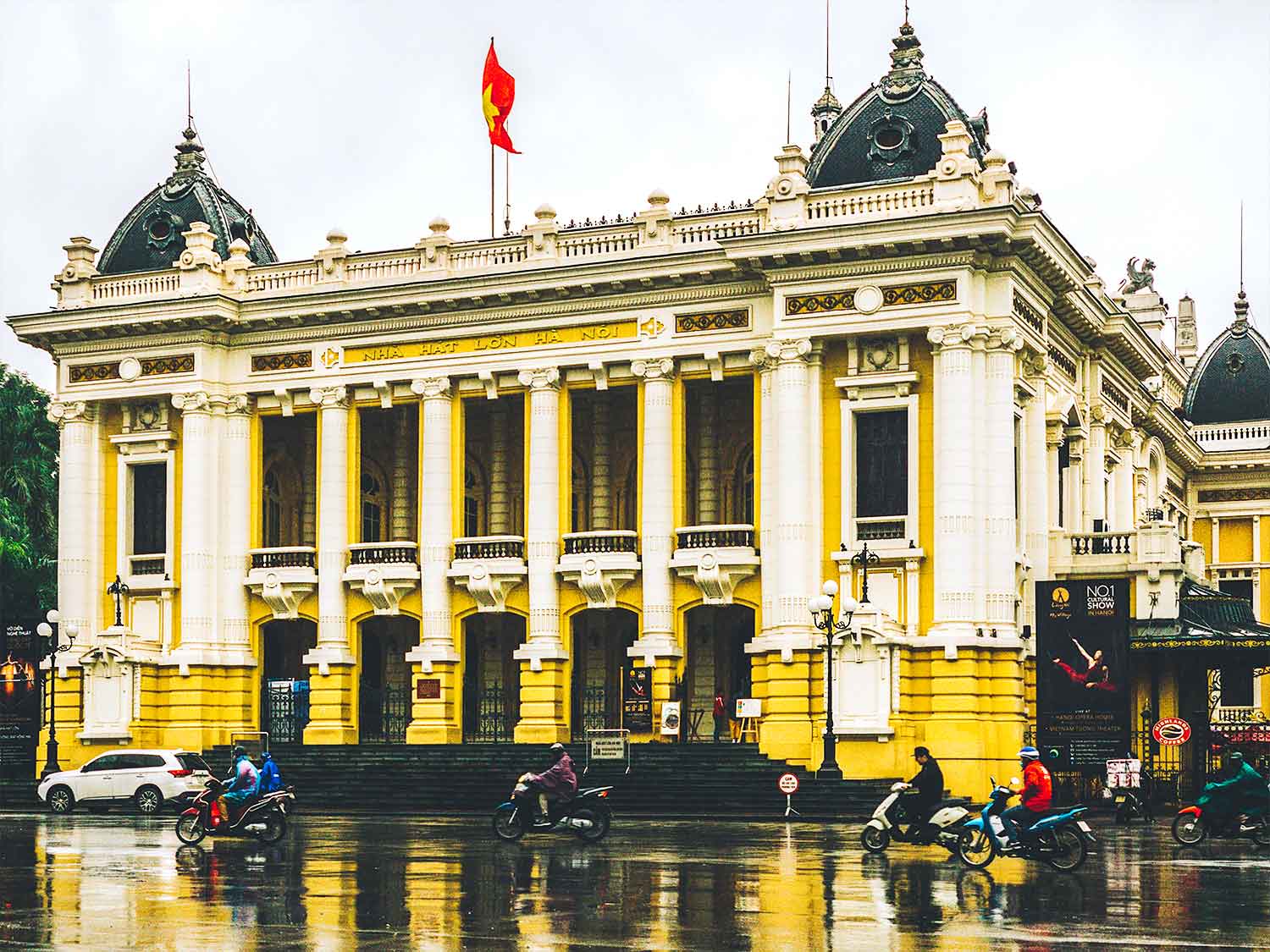At Hanoi's Old Quarter
At the Hanoi Opera House, locals have massed again and again to mark momentous events. In 1945, Uncle Ho proclaimed a sovereign Vietnam to them.

Sundays and Saturdays
Weekends, the streets of the Old Quarter are closed for traffic. Only children may drive then, which they do in large toy-cars rented on the spot. The kids zigzag in the streets before parents and uncles and aunts who coo and take pictures of their feats. The toy cars sport the logos of big brands — Mercedes, Audi, Caterpillar. Toy armoured-cars are available as well, guns and all, but parents had mostly picked the civilian types. Their driving was concentrated on the Triang Thi and Dinh Trieng Hoang.
Most of Dinh Trieng Hoang was taken over by teens and the twenty-somethings. The ladies danced; the men filmed them. The dances were set to western pop/rock, and as one group performed, another got ready on the sidewalk, preening, and smoothing shiny black dresses. The hot favourite number went He’s a very bad boy. But the boys before them were a benign lot, focused on getting them right in their frames. The chill air trembled with the music, cheered by it. The breeze was skimming off the cold lake before reaching the revellers, and none were bothered by it, not even the dancers who’d put out a lot of skin.
While shooting, the men danced their own gig.
There were others taking still pictures, for women dressed in colourful dresses, Viet and Western, long and flowing, tight and sleek, posing their subjects before photogenic portals, lakeside spots, and statues on high pedestals. The gear the men had brought was top of the line — photography in Hanoi is on a par with Japan, it seemed. A Leica boutique close to the southeast corner of the lake confirmed it.
Weekdays
During weekdays traffic is thick with cars and many motorcycles weaving in and out of impossible narrows. There is every kind of ware spilling into the sidewalks. Each street is focused on its single commodity: tin cans, iron grills, gravestones, Santa Claus dresses, decorations for Christmas, Buddhist prayer articles, shiny silks and mats and carpets, meat and fruit and fish and shining vegetables, fragrant herbs and nature cures and bags and boxes and so many other things.
For some reason tourists prefer to lodge in this dense maze, so everywhere here there are hostels and hotels and spas. To help balance body and spirit, there are on the same streets temples for the Buddhist, the Taoist, and the tall St. Joseph’s Cathedral. The manger was already set up before the cathedral in anticipation of Christmas Day, with much selfie activity round it.
Among all these were tucked-in a profusion of Vietnamese cafes, and they had the most custom. The most advertised brew was egg coffee. The establishment that was packing the most people was the Water Puppet Theater across from the corner of the lake, which runs full, several shows a day. The water puppet show is an old tradition from the countryside, performed there when rivers flood — proof of the well-known Viet forbearance.
Occasionally, white men on mopeds zipped past and shot into side streets with motoring skills that surpassed the locals — Western backpackers, who settle in anywhere.
I was happiest in the streets before the Opera House and the Le Thai To Street along the west of the lake. These are gentrified, made for easy strolling as in Europe. Across from the Opera House are Boss and Hermes and high street stores, and in front of them, the sidewalks are wider. The hotels Metropole and the De L’Opera are a big presence here. The Hilton cannot call itself the Hanoi Hilton; infamous Hanoi Hilton precedes it, and it is better known. I found a restaurant with leafy interiors quite near the Opera, the La Lua Wild Rice, where I enjoyed in its pleasing interiors, on three days, and at leisure, vegan Vietnamese lunch.
At the Opera House, the locals have been massing again and again over the years, to mark momentous events. In 1945, for instance, their Uncle Ho proclaimed a sovereign Vietnam to his countrymen. It is built to resemble the Palais Garnier, says Wikipedia, and it is indeed a lovely approximation. The great building has welcomed its people to celebrate victories before it In 1945, and 1954, and 1975, and 1979. Announcing reunification in 1975, although military parades and processions happened all over town, and the military celebrated in full force before the gates of the Thang Long Citadel, it was before the Opera House that the Hanoians rejoiced with the spontaneity of their hearts.
Returning often, I lingered in the cold and the wet before the Opera House, with scooters buzzing by, and cars flitting across, splashing rainwater as they sped. I experienced a warm communion with the Vietnamese, and their history, a past that moves every human.
